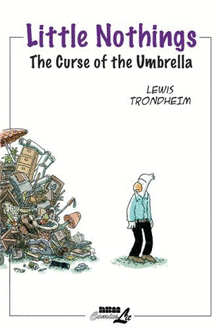NBM · 2006-2007

Sorry; this was supposed to be a Saturday thing. Minor though persistent illness and a gnawing feeling of having bitten off more than I can chew have kept me mostly silent all weekend. On the plus side, I've caught up on my Hulu viewing, amused myself in the usual ways one does online, and rested enough to make sure my health is ready to cope with another work week; on the minus, a wholly arbitrary schedule I set for myself has been knocked askew. Guess which one matters to me more.
Somehow I think Lewis Trondheim would relate. He's been chronicling the petty aggravations, pop-culture fantasies, and minor triumphs of an obssessive-complusive, paranoid, superstitious, and reluctantly adult bird-man named Lewis Trondheim for most of the decade at his website. So far four volumes of his "petits riens" have been published in French; with the usual lag in translation, two volumes in English have so far turned up.
It's probably appropriate to add here that Lewis Trondheim is one of my personal heroes (the only other living one is Paul F. Tompkins), my most direct inspiration to take up pen and ink and try to cartoon at all. His deceptively basic approach to cartooning, with simplified animal figures standing in for humans, was a breath of fresh air when I discovered the two volumes of Lapinot that Fantagraphics had translated into English at the end of the 90s; his shaggy-dog approach to storytelling, which involves just as much hanging out with friends and petty arguing as plotting, helped to rescue me from the idea that for comics to be great they had to take themselves seriously, and his refusal to be bound by the laws of time and space (each volume of Lapinot involves the same characters but takes place in a different historical era) has, now that I think about it, probably influenced my worldview and critical infrastructure more than any other single work.
But we're talking here about Little Nothings. As someone who has wrestled however ineptly with volume, line, and shape, I still deeply admire Trondheim's chicken-scratch solutions to those problems, his loose line filling in details without cluttering up the page, the European tradition of clear-line cartooning retaining its elegance even as Trondheim presents a modern Europe (and everywhere else) which has degenerated and scuzzed over since the era of Hergé. He's only grown in confidence and ability since the era when I fell in love with him, as the increasingly gorgeous watercolor washes behind his thin, unsteady line demonstrate.
These books are an determinedly minor entry in Trondheim's bibliography — although, ever since Lapinot ended, they're very nearly the only thing he's done all by himself, without scripting for others or having a rotating cast fill out his sketches. This isn't necessarily a bad thing — all of his collaborators, nearly without exception, are also great cartoonists — but it means that those of us who jones for the uncut Trondheim will have to be satisfied with these minor observations and quick sketches capturing a single mood. He's frequently very funny; but it's the quotidian humor of everyday life, of minor inconsistencies and anecdotes traded over a few too many glasses. For the uncut Trondheim on a more epic scale, I'll have to turn to Lapinot.
Which I will. But since it's still (mostly) in French, I'll have to wait for when I'm feeling better. I don't know about you, but I can't translate on the fly from a language I've never formally studied when I'm sick.
I'll leave you with this. From NBM's blog, one of the more beautiful single-page strips from the second volume:

No comments:
Post a Comment